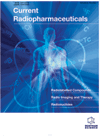- Home
- A-Z Publications
- Current Radiopharmaceuticals
- Previous Issues
- Volume 16, Issue 1, 2023
Current Radiopharmaceuticals - Volume 16, Issue 1, 2023
Volume 16, Issue 1, 2023
-
-
Evaluation of the Effect of Chelating Arms and Carrier Agents on the Radiotoxicity of TAT Agents
More LessTargeted Alpha Therapy (TAT) is considered an evolving therapeutic option for cancer cells, in which a carrier molecule labeling with an α-emitter radionuclide make the bond with a specific functional or molecular target. α-particles with high Linear Energy Transfer (LET) own an increased Relative Biological Effectiveness (RBE) over common β-emitting radionuclides. Normal tissue toxicity due to non-specific uptake of moth Read More
-
-
-
A Brief Review of Radioactive Materials for Therapeutic and Diagnostic Purposes
More LessRadiation treatment has been advancing ever since the discovery of X-rays in 1895. The goal of radiotherapy is to shape the best isodose on the tumor volume while preserving normal tissues. There are three advantages: patient cure, organ preservation, and cost-effectiveness. Randomized trials in many various forms of cancer (including breast, prostate, and rectum) with a high degree of scientific proof confirmed radiother Read More
-
-
-
Synthesis and Ready to Use Kit Formulation of EDTMP for the Preparation of 177Lu-EDTMP as a Bone Palliation Radiopharmaceutical
More LessAuthors: Guldem Mercanoglu, Kani Zilbeyaz and Nuri ArslanIntroduction: With its suitable nuclear decay characteristics and large-scale production feasibility with adequate specific activity, 177Lu is regarded as an excellent radionuclide for developing bone pain palliation agent. Ethylenediamine-tetramethylene phosphonic acid (EDTMP) is a preferred carrier molecule for radiolanthanides, such as 177Lu. The present paper describes the synthesis of EDTMP and the development of a re Read More
-
-
-
Dosimetric Comparison of Different Radionuclides Used in Metastatic Bone Disease Treatment
More LessIntroduction: This study aimed to determine the critical organ doses in 223Ra, 89Sr, 153Sm, and 32P treatments via dosimetry using the phantoms. Material and Methods: The OpenDose was used to calculate S values (mGy MBq-1s-1) for bone surface, red bone marrow, urinary bladder wall, testes, ovaries, uterus, and kidneys using male (ICRP110AM) and female (ICRP110AF) phantoms. The cortical thoracic spine was modele Read More
-
-
-
The Undervalued Acute Leukopenia Induced By Radiotherapy In Cervical Cancer
More LessAuthors: Xiaoxian Ye, Jianliang Zhou, Shenchao Guo, Pengrong Lou, Ruishuang Ma and Jianxin GuoBackground: Myelosuppression is common and threatening during tumor treatment. However, the effect of radiation on bone marrow activity, especially leukocyte count, has been underestimated in cervical cancer. The aim of this study was to evaluate the severity of radiotherapy- induced acute leukopenia and its relationship with intestinal toxicity. Methods: The clinical data of 59 patients who underwent conventional radiati Read More
-
-
-
Histopathological Evaluation of Nanocurcumin for Mitigation of Radiation- Induced Small Intestine Injury
More LessAim: In the current study, we aimed to mitigate radiation-induced small intestinal toxicity using post-irradiation treatment with nano-micelle curcumin. Background: Small intestine is one of the most radiosensitive organs within the body. Wholebody exposure to an acute dose of ionizing radiation may lead to severe injuries to this tissue and may even cause death after some weeks. Objective: This study aimed to evaluate Read More
-
-
-
Estimation of Human Absorbed Dose of 188Re-Hynic-Bombesin Based on Biodistribution Data in Rats
More LessBackground: HYNIC-Bombesin (BBN) is a potential peptide for targeted radionuclide therapy in gastrin-releasing peptide receptor (GRPr)-positive malignancies. The 188Re-HYNICBBN is a promising radiopharmaceutical for use in prostate cancer therapy. Objective: The aim of this study was to estimate the absorbed dose due to 188Re-HYNIC-BBN radio-complex in human organs based on bio-distribution data of rats. Methods: In Read More
-
-
-
Evaluation of the Mitigation Effect of Spirulina Against Lung Injury Induced by Radiation in Rats
More LessBackground: Some compounds have been investigated to mitigate the effect of radiation on the lung, such as pneumonitis and fibrosis. Objective: This study aimed to examine the mitigation efficiency of Spirulina compared to the effect of Metformin. Methods: 25 male Wistar rats were allotted in five groups: control, Spirulina, Radiation, Radiation plus Spirulina, and Radiation plus Metformin. Rat chest regions were irradiated by Read More
-
-
-
Evaluating the Mitigation Effect of Spirulina Against Radiation-Induced Heart Injury
More LessBackground: During a radiological or nuclear disaster, exposure to a high dose of ionizing radiation usually results in cardiovascular diseases such as heart failure, attack, and ischemia. Objective: The purpose of this study was to examine the mitigation effects of Spirulina in comparison to Metformin's. Methods: 25 male Wistar rats were randomly assigned to five groups (5 rats in each): for the control group, rats did not rec Read More
-
Most Read This Month
Article
content/journals/crp
Journal
10
5
false
en


